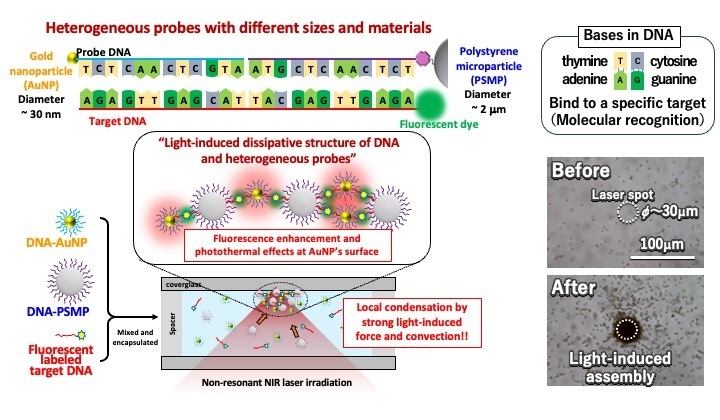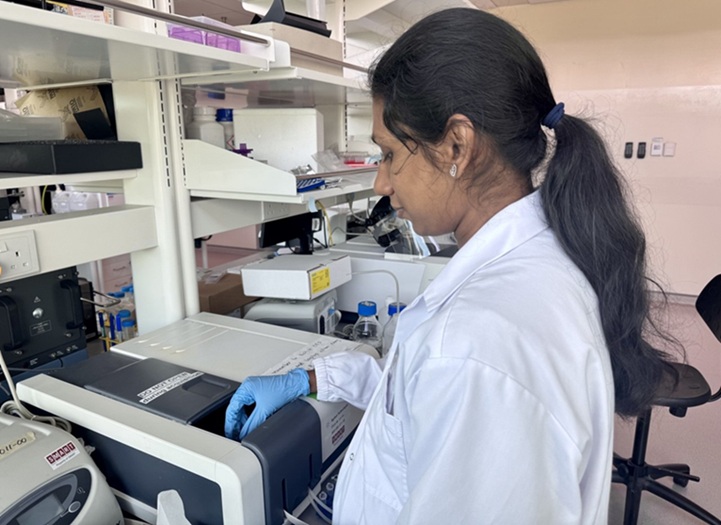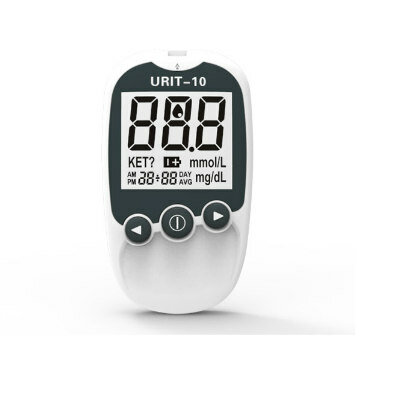BRAF Mutation Discovered in Hairy-Cell Leukemia
|
By LabMedica International staff writers Posted on 16 Jun 2011 |
The BRAF V600E mutation was present in all patients with hairy-cell leukemia (HCL) who were evaluated. This finding has implications for the diagnosis, pathogenesis, and targeted therapy of HCL.
Scientists looked for HCL-associated mutations by performing massively parallel sequencing of the whole exome of leukemic and matched normal cells purified from the peripheral blood of an index patient with HCL. Findings were validated by Sanger sequencing in 47 additional patients with HCL.
Hairy-cell leukemia (HCL) is a well-defined clinicopathological entity whose underlying genetic lesion is still obscure. The single mutation occurred in every patient in a cohort with hairy cell leukemia, suggesting that targeting the mutation could have major implications for treating the disease, Italian investigators reported.
Gene-expression profiling and genome-wide single-nucleotide polymorphism genotyping failed to pinpoint any recurrent genetic alterations in HCL.
Brunangelo Falini, MD , Enrico Tiacci, MD , and colleagues of the University of Perugia (Italy) using the more powerful approach to examining the genetic basis of cancer: genome-wide massively parallel sequencing of tumor and normal cells from the same patient. They sought to identify recurrent somatic mutations in protein-coding genes, with the goal of gaining more insight into the origin of the disease and identifying new options for diagnosis and treatment.
A consequence of this discovery may be that specific drugs/molecules can be developed that inhibit the activated, mutated BRAF gene, thereby preventing continuous stimulation of leukemic cells to divide. The first laboratory results employing these specific inhibitors show promising results.
Hairy cell leukemia is characterized by the piling up of leukemic cells in the bone marrow with a lack of production of normal blood cells, which might be life-threatening, as well as a large spleen, which may lead to significant complaints to the patients involved.
"The BRAF V600E mutant is a potential therapeutic target in patients with hairy cell leukemia who do not have a response (or have a suboptimal response) to initial therapy with purine analogs, as well as in patients with repeated relapses or unacceptable toxic effects," Dr. Falini and coauthors wrote in conclusion.
"Notably, BRAF V600E inhibitors have shown remarkable activity in patients with BRAF-mutated metastatic melanoma. These results, along with our in vitro finding that a specific active BRAF inhibitor causes MEK and ERK dephosphorylation in primary hairy cell leukemia cells, warrant the clinical testing of active BRAF inhibitors."
The findings were published online in the New England Journal of Medicine (NEJM) on June 11, 2011.
Related Links:
University of Perugia
Scientists looked for HCL-associated mutations by performing massively parallel sequencing of the whole exome of leukemic and matched normal cells purified from the peripheral blood of an index patient with HCL. Findings were validated by Sanger sequencing in 47 additional patients with HCL.
Hairy-cell leukemia (HCL) is a well-defined clinicopathological entity whose underlying genetic lesion is still obscure. The single mutation occurred in every patient in a cohort with hairy cell leukemia, suggesting that targeting the mutation could have major implications for treating the disease, Italian investigators reported.
Gene-expression profiling and genome-wide single-nucleotide polymorphism genotyping failed to pinpoint any recurrent genetic alterations in HCL.
Brunangelo Falini, MD , Enrico Tiacci, MD , and colleagues of the University of Perugia (Italy) using the more powerful approach to examining the genetic basis of cancer: genome-wide massively parallel sequencing of tumor and normal cells from the same patient. They sought to identify recurrent somatic mutations in protein-coding genes, with the goal of gaining more insight into the origin of the disease and identifying new options for diagnosis and treatment.
A consequence of this discovery may be that specific drugs/molecules can be developed that inhibit the activated, mutated BRAF gene, thereby preventing continuous stimulation of leukemic cells to divide. The first laboratory results employing these specific inhibitors show promising results.
Hairy cell leukemia is characterized by the piling up of leukemic cells in the bone marrow with a lack of production of normal blood cells, which might be life-threatening, as well as a large spleen, which may lead to significant complaints to the patients involved.
"The BRAF V600E mutant is a potential therapeutic target in patients with hairy cell leukemia who do not have a response (or have a suboptimal response) to initial therapy with purine analogs, as well as in patients with repeated relapses or unacceptable toxic effects," Dr. Falini and coauthors wrote in conclusion.
"Notably, BRAF V600E inhibitors have shown remarkable activity in patients with BRAF-mutated metastatic melanoma. These results, along with our in vitro finding that a specific active BRAF inhibitor causes MEK and ERK dephosphorylation in primary hairy cell leukemia cells, warrant the clinical testing of active BRAF inhibitors."
The findings were published online in the New England Journal of Medicine (NEJM) on June 11, 2011.
Related Links:
University of Perugia
Latest Molecular Diagnostics News
- Cheap Cell-Free DNA Based Test Accurately Predicts Preterm Birth
- RNA Blood Test Detects Cancers and Resistance to Treatment
- IL-6 Outperforms Traditional Tests for Early Sepsis Detection
- Simple Blood Test Improves Heart Attack and Stroke Risk Prediction
- Blood Biomarker Test Could Detect Genetic Predisposition to Alzheimer’s
- Novel Autoantibody Against DAGLA Discovered in Cerebellitis
- Blood Test Could Identify Patients at Risk for Severe Scleroderma
- Gene-Based Blood Test Accurately Predicts Tumor Recurrence of Advanced Skin Cancer
- Rapid Blood Test Identifies Pre-Symptomatic Patients with Parkinson’s Disease
- Blood Test for Early Alzheimer's Detection Achieves Over 90% Accuracy
- RNA-Based Blood Test Detects Preeclampsia Risk Months Before Symptoms
- First Of Its Kind Test Uses microRNAs to Predict Toxicity from Cancer Therapy
- Novel Cell-Based Assay Provides Sensitive and Specific Autoantibody Detection in Demyelination
- Novel Point-of-Care Technology Delivers Accurate HIV Results in Minutes
- Blood Test Rules Out Future Dementia Risk
- D-Dimer Testing Can Identify Patients at Higher Risk of Pulmonary Embolism
Channels
Clinical Chemistry
view channel
‘Brilliantly Luminous’ Nanoscale Chemical Tool to Improve Disease Detection
Thousands of commercially available glowing molecules known as fluorophores are commonly used in medical imaging, disease detection, biomarker tagging, and chemical analysis. They are also integral in... Read more
Low-Cost Portable Screening Test to Transform Kidney Disease Detection
Millions of individuals suffer from kidney disease, which often remains undiagnosed until it has reached a critical stage. This silent epidemic not only diminishes the quality of life for those affected... Read more
New Method Uses Pulsed Infrared Light to Find Cancer's 'Fingerprints' In Blood Plasma
Cancer diagnoses have traditionally relied on invasive or time-consuming procedures like tissue biopsies. Now, new research published in ACS Central Science introduces a method that utilizes pulsed infrared... Read moreHematology
view channel
New Scoring System Predicts Risk of Developing Cancer from Common Blood Disorder
Clonal cytopenia of undetermined significance (CCUS) is a blood disorder commonly found in older adults, characterized by mutations in blood cells and a low blood count, but without any obvious cause or... Read more
Non-Invasive Prenatal Test for Fetal RhD Status Demonstrates 100% Accuracy
In the United States, approximately 15% of pregnant individuals are RhD-negative. However, in about 40% of these cases, the fetus is also RhD-negative, making the administration of RhoGAM unnecessary.... Read moreImmunology
view channel
Stem Cell Test Predicts Treatment Outcome for Patients with Platinum-Resistant Ovarian Cancer
Epithelial ovarian cancer frequently responds to chemotherapy initially, but eventually, the tumor develops resistance to the therapy, leading to regrowth. This resistance is partially due to the activation... Read more
Machine Learning-Enabled Blood Test Predicts Immunotherapy Response in Lymphoma Patients
Chimeric antigen receptor (CAR) T-cell therapy has emerged as one of the most promising recent developments in the treatment of blood cancers. However, over half of non-Hodgkin lymphoma (NHL) patients... Read moreMicrobiology
view channel
Handheld Device Delivers Low-Cost TB Results in Less Than One Hour
Tuberculosis (TB) remains the deadliest infectious disease globally, affecting an estimated 10 million people annually. In 2021, about 4.2 million TB cases went undiagnosed or unreported, mainly due to... Read more
New AI-Based Method Improves Diagnosis of Drug-Resistant Infections
Drug-resistant infections, particularly those caused by deadly bacteria like tuberculosis and staphylococcus, are rapidly emerging as a global health emergency. These infections are more difficult to treat,... Read more
Breakthrough Diagnostic Technology Identifies Bacterial Infections with Almost 100% Accuracy within Three Hours
Rapid and precise identification of pathogenic microbes in patient samples is essential for the effective treatment of acute infectious diseases, such as sepsis. The fluorescence in situ hybridization... Read morePathology
view channel
Rapid, Ultra-Sensitive, PCR-Free Detection Method Makes Genetic Analysis More Accessible
Genetic testing has been an important method for detecting infectious diseases, diagnosing early-stage cancer, ensuring food safety, and analyzing environmental DNA. For a long time, polymerase chain reaction... Read more
Spit Test More Accurate at Identifying Future Prostate Cancer Risk
Currently, blood tests that measure the level of a protein called prostate-specific antigen (PSA) are commonly used to identify men at higher risk for prostate cancer. This test is typically used based... Read moreDNA Nanotechnology Boosts Sensitivity of Test Strips
Since the Covid-19 pandemic, most people have become familiar with paper-based rapid test strips, also known as lateral flow immunoassays (LFIAs). These tests are used to quickly detect biomarkers that... Read more
Novel UV and Machine Learning-Aided Method Detects Microbial Contamination in Cell Cultures
Cell therapy holds great potential in treating diseases such as cancers, inflammatory conditions, and chronic degenerative disorders by manipulating or replacing cells to restore function or combat disease.... Read moreTechnology
view channel
Disposable Microchip Technology Could Selectively Detect HIV in Whole Blood Samples
As of the end of 2023, approximately 40 million people globally were living with HIV, and around 630,000 individuals died from AIDS-related illnesses that same year. Despite a substantial decline in deaths... Read more
Pain-On-A-Chip Microfluidic Device Determines Types of Chronic Pain from Blood Samples
Chronic pain is a widespread condition that remains difficult to manage, and existing clinical methods for its treatment rely largely on self-reporting, which can be subjective and especially problematic... Read more
Innovative, Label-Free Ratiometric Fluorosensor Enables More Sensitive Viral RNA Detection
Viruses present a major global health risk, as demonstrated by recent pandemics, making early detection and identification essential for preventing new outbreaks. While traditional detection methods are... Read moreIndustry
view channel
Cepheid and Oxford Nanopore Technologies Partner on Advancing Automated Sequencing-Based Solutions
Cepheid (Sunnyvale, CA, USA), a leading molecular diagnostics company, and Oxford Nanopore Technologies (Oxford, UK), the company behind a new generation of sequencing-based molecular analysis technologies,... Read more
Grifols and Tecan’s IBL Collaborate on Advanced Biomarker Panels
Grifols (Barcelona, Spain), one of the world’s leading producers of plasma-derived medicines and innovative diagnostic solutions, is expanding its offer in clinical diagnostics through a strategic partnership... Read more









.jpg)









